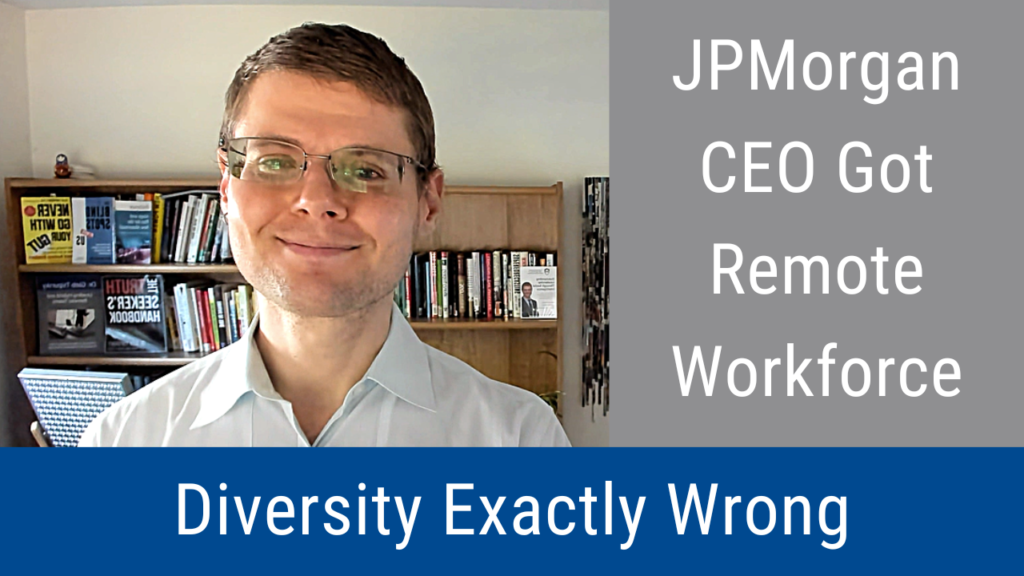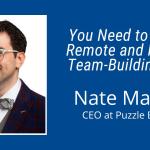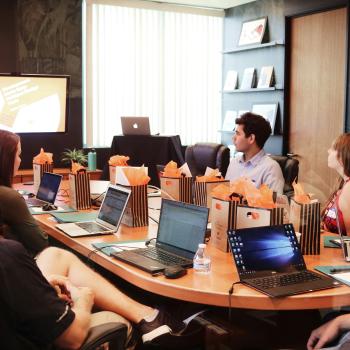
JPMorgan CEO Jamie Dimon is wrong: remote work helps workforce diversity, while a forced return to office hurts it. Adopting best practices for workforce diversity in remote work will help firms exceed diversity targets and financial performance, as it helped Meta. That’s the key take-away message of this episode of the Wise Decision Maker Show, which describes how the CEO of JPMorgan got remote workforce diversity exactly wrong.
Video: “JPMorgan CEO Got Remote Workforce Diversity Exactly Wrong”
Podcast: “JPMorgan CEO Got Remote Workforce Diversity Exactly Wrong”
Links Mentioned in Videocast and Podcast
- Here is the article: JPMorgan CEO Got Remote Workforce Diversity Exactly Wrong
- The book Leading Hybrid and Remote Teams: A Manual on Benchmarking to Best Practices for Competitive Advantage is available here.
- You are welcome to register for the free Wise Decision Maker Course
Transcript
Hello, everyone, and welcome to another episode of the wise decision maker show where we help you make the wisest and most profitable decisions. And today we’ll talk about remote work and diversity. Specifically, JP Morgan CEO Jamie Dimon said that diversity and remote work don’t go together. He said that going back to the office will improve diversity and staying working from home will harm diversity therefore. So that’s what he said. Now, is he right? If he’s right, that’s important because a diverse workforce definitely helps improve financial performance. So does returning to the office help diversity? Not really, if you look at the evidence, the opposite is actually true. Remote work is what improves diversity. The return to the office harms diversity. So when you look at the research, it shows pretty clearly that firm diversity correlates with improved financial results. So the more diversity is an affirm, the more you have people of various underrepresented groups in the firm, then the more you improve your financial research results, and you have teams with diverse participants, the more diverse the team, the better the decisions they make. So we clearly know that diversity is good for financial performance and good for decision making, which is also good for financial performance. But what you really want to understand is that we clearly have evidence both from large companies and from surveys, that remote work, more remote work, so not mostly or fully in office work, but mostly or fully remote work. That’s what correlates with diversity. So let’s talk about a specific company, a large company, you might have heard of it called meta, what used to be called Fairy spoke, it found that remote work led to a more diverse workforce in its efforts to actually hire a diverse workforce. So as the epidemic started, Mehta decided to offer fully permanent, remote work options for its work so that you don’t have to return to the office. You can work fully remotely if your position allows it. And many, many positions at Mehta allow working fully remotely for current and new employees. Their results really show the Jamie diamonds claims the CEO of JPMorgan are incorrect. Matter actually saw a really large increase in stay first hires meaning blacks, Hispanics, Native Americans, people with disabilities, veterans, women, and remember, women are underrepresented groups in the tech sector. Let’s take a look at its 2022 diversity report from which this information comes now in 2019. So before the pandemic met and made a five year plan, with certain diversity goals that at one reached by 2024. And what it found was that it achieved its 2024, five year diversity goals two years ahead of schedule. So in three years, that’s very unusual. Companies usually underperform other diversity goals. So that five year timescale, the regular expected scenario is that Mehta would have achieved some but not all of its diversity goals. But now, already two years ahead of schedule, they over achieved his diversity goals. And that is just due to remote work, due to the option of working remotely for its staff. So what happened, there has been a lot of improvement in medicine. 2019 It doubled the number of women in its global workforce around the world, and Black and Hispanic workers in the US, which is part of what it is, which is its goals in the 2019 plans for five years. If achieved those goals in 2022. In three years, it also increased and this is separately this was not a goal, but that it set out to achieve in 2019. But it found that because of its remote work options, it also increased the number of employees with disabilities from 4.7% to 6.2%, which is a pretty large jump. Now, the Metro chief diversity officer said that the candidates who accepted job offers for remote positions were much more likely substantially more likely that’s exactly what they said, quote, substantially more likely, unquote, to come from diverse communities, underrepresented groups, so including ethnic diversity, so people who are black, Hispanic, Alaskan Native Native American, and other groups that are underrepresented in the tech sector, like people with disabilities, veterans, women. So these are the kinds of groups that Metis saw were substantially more likely to accept remote positions whose mentor was offering methods VP of Workforce Diversity inclusions different than the chief diversity officer said that in quote, embracing remote work and being distributed first has allowed me to to become a more diverse company on Vote. So again, this is all because the underrepresented groups were much more likely to apply for and take the positions that meta was offering. working remotely. Research shows that people of color, and other underrepresented groups clearly prefer remote work. So there was a future form survey which found that talking about support for full time in office return among knowledge workers, so white knowledge workers, 21% of them wanted full time in office work. What about black knowledge workers? Only 3% Only 3% of black knowledge workers want to work full time in the office, and the support for a fully flexible schedule. Let’s talk about another dimension of things. Men, let’s take a look at them. 26% of white men want a fully flexible schedule. So complete flexibility. But 30% of black men want that schedule. What about women 25% of white women want that schedule and 33% of black women want that schedule. So clearly, we see that again, underrepresented groups want a more flexible schedule, there was a study by the Society for Human Resource Management survey, which found that workers support for permanent work from home white workers are 39% Want fully complete, just work from home, while black knowledge workers 50% of them want complete want to work from home all the time. So again, a pretty large, larger number of black workers and white workers want to work from home at all times. Now, why do so many people of color not want to return to the office? Well, because black workers are less vulnerable to discrimination, microaggressions and other sorts of harassment when they’re not there in the office. So they’re also free from code switching, which means accommodating their ways that their cultural norms to the white mainstream norm. So speech, appearance and behavior. So that is also quite a burden and drain for black workers. And they don’t have to do that if they’re not coming to the office. So the desire for remote work among other underrepresented groups matches or exceeds that of black workers. We know that other underrepresented groups also want to work more remotely. For example, women have more non-work responsibilities like household chores, child care, caring for elderly, parents, and so on. People with disabilities. Well, if they’re at home, those who have disabilities can have better accommodation overall. And they don’t have to deal with the stress of the commute, which again, for people with disabilities tends to be challenging. And then avoid having to deal with common side glances by coworkers, which is pretty annoying and draining for people with disabilities. Unfortunately, cognitive biases these dangerous mental errors that we all tend to experience as human beings cause leaders to make bad decisions on diversity, equity and inclusion. For example, Jamie Dimon, he fell victim likely to a number of mental blind spots, for example, the belief bias, which is evaluating claims based on what we want to be true, rather than what is the actual date, we see very clearly from the date that you know, you assign a summer intern to look at the data, you will very clearly find that black workers overall, women overall people with disabilities overall, and other sorts of veterans have a much stronger preference for remote work rather than coming into the office. And obviously, coming to the office hurts diversity, which remotely helps diversity as matter is found. The confirmation bias is another one, it’s looking for information that confirms our beliefs and rejecting information that goes against our beliefs. So that belief bias and confirmation bias, likely what led Jamie Dimon astray and many, many other leaders who make similar claims. Now, that doesn’t mean that remote work is a punishment for people in underrepresented groups, you still have to address some real issues in remote jobs, whether they’re fully remote or part time remote, which we call hybrid, you still have to address those issues. For example, in virtual meetings, there are still some challenges like bullying of underrepresented groups, harassment of these groups, mansplaining and interruptions, which is men interrupting women frequently and trying to explain things to women that women already know. That’s what mansplaining is. That’s what the term meets. Now, how do you support underrepresented groups in these meetings? Well, you want to train staff to help hybrid and remote meetings that are going to address the issues being inclusive and sensitive to diversity concerns. So train staff on these issues. It’s very important that hybrid meetings are and remote meetings are different from in person meetings. So people need to be trained on how to manage them effectively, especially in such a way as to address the issues. Now, how do you manage these interruptions of your manager? So here’s the checklist. Let all attendees finish their thoughts, and make sure that other people don’t interrupt them. And again, stop those interrupting others and stop people from talking over each other. That’s really important. Use the raise hand function for q&a sessions that’s quite useful, or have people chat in the chat and your questions instead of interrupting that’s quite useful. Now, if you see bowling, how do you deal with that? Well, you want to check with your own fitter presented staff about bullying first, you might see it, but you should also solicit the given information out there, don’t assume that just because he doesn’t see that doesn’t happen, then you want to be trained as a manager. So train your managers to talk to the people who engage in bullying, about what is appropriate, and what is inappropriate workplace behavior, and manage and work with them to change those problematic behavior patterns. Now, another area that you really want to work on is boosting social connections, it’s especially important for underrepresented groups, we know that there was a decrease in connection overall among remote workers. That’s a common challenge. remote workers tend to form increased connections with those in their own team, but decrease connections with those outside their team, the number of connections overall, among new hires is down 17%. Because again, they form connections with those in their team, but they form less connections with those outside the gym, because they see them less, right. They’re working remotely. So that’s a problem. Now, what you want to do is increase cross functional collaboration through mentoring, pairing junior staff, with senior colleagues. So having these mentoring relationships is really important. So how do you do this? Well, the barriers to advancement for underrepresented groups with very clear, extensive research shows come from a lack of connection to senior staff like informal mentoring, sponsorship, and so on. So you want to create a formal mentoring program to address these problems, provide minority staff with two senior mentors, one from the same minority group, and one from the majority group. And these people should be from outside their immediate team. So just having those mentors be from outside their immediate team, that’s really useful. So that is a very good strategy to provide minority staff with these mentors. And that’s something that we’re doing at the University of Southern California Information Sciences Institute. That’s one of my clients. And we’re creating a mentoring program that specifically has that dimension, where one of the people who will be mentoring that person, we’re going to make aiming to match them, to have a minority staff member have someone from their own minority group to get that support. That would not be coming from someone who is not from that same minority group and doesn’t know the kind of issues that that person is dealing with. They don’t know those issues viscerally. Third, the benefits is that have you’ll have a diverse network of connections and opportunity to draw on the experience of people who are from the same minority group, same underrepresented group, that is quite useful, because they understand the kind of challenges that the represented person is experiencing that someone who is in the mainstream group would not. But you also want someone from the mainstream to connect that person who is being mentored to mainstream opportunities and contacts. So both from the underrepresented group and the mainstream groups, you’ll get implicit knowledge and valuable relationships. Also, the fact that it’s two mentors lessens the workload for each mentor. So that’s quite useful as well. So the best practice for an effective mentoring program is to link mentoring to performance evaluation for each mentor, make sure that that’s part of the way that the mentor is evaluated on how well they’re doing mentoring as part of their performance evaluation. More broadly, you want to have a survey that measures di efforts, internal surveys that could identify the eye issues, and then take steps to remedy these issues. Right. So you’ll use the survey to ask underrepresented staff. So focus on the underrepresented staff about what the experience was with di challenges, ideas to solve these issues most effectively. And then you want to grade this feedback into your diversity, equity and inclusion plans. So to implement a diverse, inclusive culture in the workplace, you really need to address these problems. So you survey these issues. And then once you know the nature of the problem, once you notice its extent, create an effective diversity equity inclusion plan to fix it by integrating the solutions we discussed here. So things like the mentoring program Like addressing bullying, and so on, and then measuring how well you are improving diversity, equity inclusion by running surveys once again. And so you want to adopt these best practices for diversity and Hybrid Hybrid and remote work. And if you avoid the mistakes of executives like Jamie Dimon, like failing to look at the hard data and making false claims that just align with your beliefs, and not hiring a summer intern to actually research these things, you’ll get much better off, you’ll have the same kind of benefits that matter got, you will outperform your diversity goals, and you will improve your financial performance. Because again, good diversity is strongly linked to good financial performance. Alright, I hope you’ve enjoyed this episode of the wise decision maker show. My name is Dr. Gleb Tsipursky, I’m the CEO of disaster avoidance experts, the future of work consultancy that sponsors the wise decision maker show, please make sure to leave a review for the show, wherever you checked it out whether it’s iTunes or elsewhere. That’s very helpful for other people to discover the show and for me to learn more about what you prefer, so I can change the show to align with your preferences. And please make sure to subscribe to the show again, wherever you check that out. We are videocast and podcast form. So if you haven’t done YouTube, subscribe there. Have iTunes check it out there. Alright everyone. I look forward to seeing you on the next episode of the wise decision maker show. And in the meantime, the wisest and most profitable decisions to you, my friends.
Transcribed by https://otter.ai
Originally Published at Disaster Avoidance Experts on November 22, 2022.
Bio: Dr. Gleb Tsipursky helps tech and finance industry executives drive collaboration, innovation, and retention in hybrid work. He serves as the CEO of the boutique future-of-work consultancy Disaster Avoidance Experts, which helps organizations adopt a hybrid-first culture, instead of incrementally improving on the traditional office-centric culture. A best-selling author of 7 books, he is especially well-known for his global best-sellers Never Go With Your Gut: How Pioneering Leaders Make the Best Decisions and Avoid Business Disasters (Career Press, 2019) and The Blindspots Between Us: How to Overcome Unconscious Cognitive Bias and Build Better Relationships (New Harbinger, 2020). His newest book is Leading Hybrid and Remote Teams: A Manual on Benchmarking to Best Practices for Competitive Advantage (Intentional Insights, 2021). His writing was translated into Chinese, Korean, German, Russian, Polish, Spanish, French, and other languages. His cutting-edge thought leadership was featured in over 650 articles and 550 interviews in prominent venues. They include Harvard Business Review, Fortune, Inc. Magazine, CBS News, Time, Business Insider, Government Executive, The Chronicle of Philanthropy, Fast Company, Boston Globe, New York Daily News, Fox News, USA Today, and elsewhere. His expertise comes from over 20 years of consulting, coaching, and speaking and training for mid-size and large organizations ranging from Aflac to Xerox. It also comes from his research background as a behavioral scientist. After spending 8 years getting a PhD and lecturing at the University of North Carolina at Chapel Hill, he served for 7 years as a professor at the Ohio State University’s Decision Sciences Collaborative and History Department. A proud Ukrainian, Dr. Gleb lives in Columbus, Ohio (Go Bucks!). In his free time, he makes sure to spend abundant quality time with his wife to avoid his personal life turning into a disaster. Contact him at Gleb[at]DisasterAvoidanceExperts[dot]com, follow him on LinkedIn @dr-gleb-tsipursky, Twitter @gleb_tsipursky, Instagram @dr_gleb_tsipursky, Facebook @DrGlebTsipursky, Medium @dr_gleb_tsipursky, YouTube, and RSS, and get a free copy of the Assessment on Dangerous Judgment Errors in the Workplace by signing up for the free Wise Decision Maker Course at https://disasteravoidanceexperts.com/newsletter/.


















